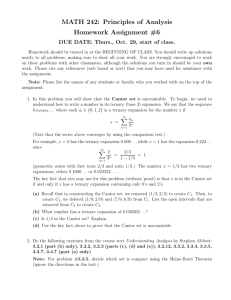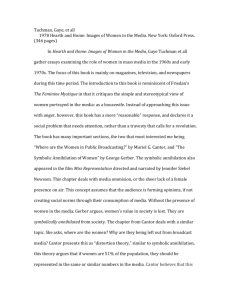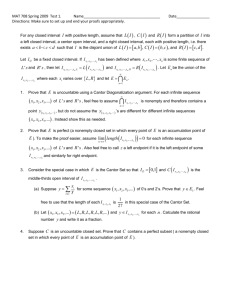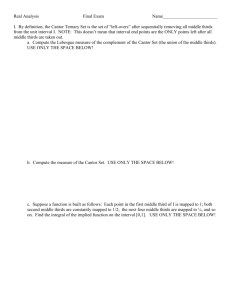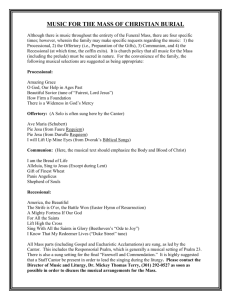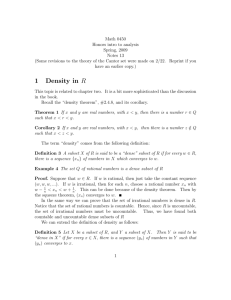THE A CANTOR MIDPOINT SET OF SET
advertisement
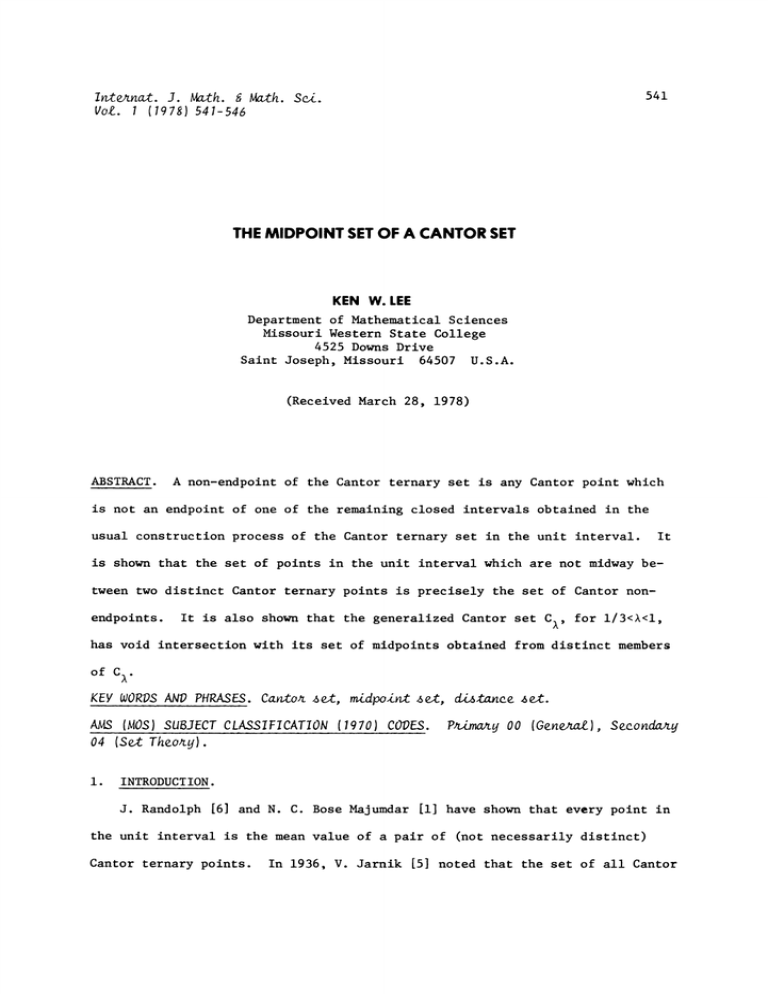
541
Internat. J. Math. & Math. Sci.
(1978)541-546
Vol.
THE MIDPOINT SET OF A CANTOR SET
KEN W. LEE
Department of Mathematical Sciences
Missouri Western State College
4525 Downs Drive
Saint Joseph, Missouri
64507
U.S.A.
(Received March 28, 1978)
ABSTRACT.
A non-endpoint of the Cantor ternary set is any Cantor point which
is not an endpoint of one of the remaining closed intervals obtained in the
usual construction process of the Cantor ternary set in the unit interval.
It
is shown that the set of points in the unit interval which are not midway be-
tween two distinct Cantor ternary points is preclsely the set of Cantor non-
endpoints.
It is also shown that the generalized Cantor set
C%,
for 1/3<%<1,
has void intersection with its set of midpoints obtained from distinct members
of
C%.
KEY WORDS AND PHRASES. Cantor set, midpoint set, distance set.
AMS (MOS) SUBJECT CLASSIFICATION (1970) CODES.
04 (Set Theory).
i.
Primay 00 (General), Secondary
INTRODUCTION.
J. Randolph [6] and N. C. Bose Majumdar [i] have shown that every point in
the unit interval is the mean value of a pair of (not necessarily distinct)
Cantor ternary points.
In 1936, V. Jarnik [5] noted that the set of all Cantor
542
K.W. LEE
points which represent an irrational number has void intersection with its set
of distinct midpoints.
Here we will characterize all points in the unit inter-
val which are not midway between two distinct Cantor points.
sent a class of Cantor-type sets with
the.
We shall also pre-
property that each member of the class
has void intersection with its set of distinct midpoints.
For certain linear sets, it has beea shown [I] that there exists a definite
relationship between the distance set and the midpoint set of the given set.
will present examples to demonstrate that this relationship cannot be extended
[I].
to n-dimensional sets as purported in
2.
BASIC CONCEPTS.
DEFINITIONS.
Let A _c R.
We define the following sets:
M(A)
{m: x+y=2m, x,yeA}
{m: x+y=2m, x#y, x,yeA}
M*(A)
CONSTRUCTION OF THE SET C
d-Ix-yl,
{d:
D(A)
Let
A
0<l<l.
delete the open middle segment of length
112
each of length (I-)/2.
121 122 123
inductively.
and
124
From the closed unit interval
l, leaving two closed intervals I II
From each of the intervals
middle open segment of length
vmls
x, yeA}
III
and
(I-I)/2, leaving four closed,
(I-)/2
of length
If we let
A
A
I
2
An
Iii u 112
4
u
2
u
12k
n
k=l
Ink’
2
Continue
112
delete the
congruent inter-
this process
We
MIDPOINT SET OF A CANTOR SET
then the set
endpoints of any
of
3.
C%.
An.
which are not
Those points in
n
n=l
shall be termed on-edpoints
in the construction of
is defined to be
C%
C%
C%
Ink
We will denote the set of non-endpoints of
M*(CI/3)
543
N.
(0,i)
_
CI/3
by N.
In this section we show that the set of points in the unit interval which
are not midway between two distinct Cantor ternary points is precisely the set
of non-endpoints of C
i/3"
(B.M. [2]).
THEOREM.
M*(CI/3)
(0,I)- N.
We complete the characterization with the following
N
THEOREM.
PROOF.
x=y=z.
c_ (0,I)
M*(CI/3).
We need only show that if z
N and x=y
2z for x,y
To accomplish this we shall show that the ternary expansion of 2z
satisfies the following property:
(*) Every w e [0,I] which can be
expressed as
w
.611621631
(base 3),
where 6. is a complex of O’s if j
is odd
(or is empty) and 6. is a complex
of 2’s if j is even (or is empty),
and the digit 1 appears an infinite
number of times, is uniquely expressable
as w
Since
CI/3,
z e N
and if
x+y, where x, y e
0 < z < 1/3, then
CI/3
(see [2].).
then
544
K.W. LEE
I =0’ =i
where
e
{0,I}
an infinite number of times,
2z
Z
i= 1
where
i
4./3
l
(i+2)
j > i.
Z
i=l
{0, I}
e
Since
(ai/3i-l+e./3i)
(ejj+l)
and
and
(aj+j+l)/3
Z
j=l
l
{0,1,2}
j
for
.(61+62 (62+63) (63+64)
el=0
s’3 (j
and
cession and consequently
2z
then since
z e
and
y
the digits 0 and 2 can never appear in sucsatisfies (*).
Hence if
< z <
I,
0 < l-z < 1/3.
then
1/3’
where
l-x, l-y e
CI/3.
It
l-z e N.
By symmetry
are Cantor ternary points such that
2(l-z)
C
x+y=2z, x,y
it follows that x=y=z.
CI/3,
2/3
Now if
(base 3).
assumes only the values 0 or I, clearly in
I)
>
2z,
(l-y)
2z < 2/3
thus,
the ternary expansion of
x
and the values 0 and 1 are both assumed
Expressed as a ternary decimal
2z
if
I,
i >
for
i,
2./3
1
E
z
follo.ws
xy=2z,
then
Thus,
(l-x)+
from the above argument
that x=y=z.
4.
A PROPERTY OF
% >1/3.
M*(C%)
In this section we demonstrate a class of sets with the property that each
member of the class has void intersection with its set of distinct midpoints.
Let %>1/3
LEMMA.
Then
x, m,
and
y
and let
or
x, m,
We induct on
Yell2
yeC%
be such that x<m<y
and
x+y
are always contained in the same closed interval
for each construction stage
PROOF.
x, m,
since
n
n.
I>I/3.
of
For
2m.
I
nk
C.
n=l, it is easily seen that
x, m, yel II
MIDPOINT SET OF A CANTOR SET
Assume that for n=t, x, m, yel
tp
Itp
segment deleted from
and let
closed intervals obtained from
of C
%>1/3,
Since
A.
PROOF.
.
interval in the construction of C
xy
2m
{x}.
I (x)
n
n
n--I
x=y,
and
Consequently
n+l-st
llt+l,j+ll.
Yelt+l,j+ 1.
...)
be the
If
x.
.
M*(C%) n C A
construction stage
x, m,
n-th
x, m,
It
stage closed
are such that
yeC%
by the preceding lemma, since
x=y=m
then it follows that
denote the open
denote the remaining
It+l,j+
containing
A
W
llt+l,jl
>
Yelt+l, j or
M*()
let In(X) (n=l,2,
and
xeC%
IWl
x, m,
For %> i/3,
Let
and
during the
tp
it follows that
immediately follows that
THEOREM.
I
Let
for some p.
It+l
545
A NOTE ON MIDPOINT SETS AND DISTANCE SETS
5.
If
A
is a symmetric subset of the closed unit interval with
it is known [i] that
[0,i]
D(A)
[i], the author attempted
[0,i].
M(A)
if, and only if,
0, leA, then
Also in
to generalize this result to higher dimensions with
the following statement.
If
,An
AI, A2,
are symmetric subsets
of the closed unit interval with
0
n)
(k=l,
le
then the distance set of
P, QeA}
P-QI
where
distance from
P
if, and only if,
While it is true that if
M()
to
A=A 1 x A x
x A
2
n’
{d: d =IP-QI,
A, D(A)
and if
denotes the Euclidean
Q,
M()
[0,i]
0, i]
[0,]
is the interval
,n).
(k=l,2,
for each
k,
D(A)
then
the converse does not hold.
EXAMPLE i.
D(A
I
x A
2)
1/3;
A
[0,],
EXAMPLE 2.
%--<
If
[0,I]
I
but
M(A2)
and
M(C%)
2
[0,1/4] u [3/4,1],
then clearly
[0,1/4] u [3/8, 5/8] u [3/4,1].
It is known (see [3])
consequently
A
[0, I]
that
D(C%)
[0,i]
if, and only if,
%--<
if, and only if,
1/3.
For
%> 1/3,
546
K.W. LEE
M(C%)
# [0,I], but
<,-
it has been shown
[4] that
D(C%
x
C%)
[0,
for
I.
REFERENCES
I.
Bose Majumder, N. C. A Study of Certain Properties of the Cantor Set and
of an (SD) Set, Bull. Calcutta Math. Soc., 54 (1962), 8-20.
2.
Bose Majumder, N. C. On the Distance Set of the Cantor Set- II, Bull.
Calcutta Math Soc., 54 (1962), 127-129.
3.
Brown, J. and Lee, K.
Analsis
The Distance Set of Certain Cantor Sets,
Exchange, Vol. 2, No. i, 1976, 48-51.
Real
J. London Math Soc.,
4.
Brown, J. and Lee, K.
15 (1977), 551-556.
5.
Jarnik, V. Sur les Fonctions de Deux Variables Reeles, Fund. Math., 27
(1936), 147-150.
6.
Randolph, J.
The Distance Set of
C% x C%,
Distances Between Points of the Cantor Set, American Math.
Monthly, 47 (1940), 549-551.
